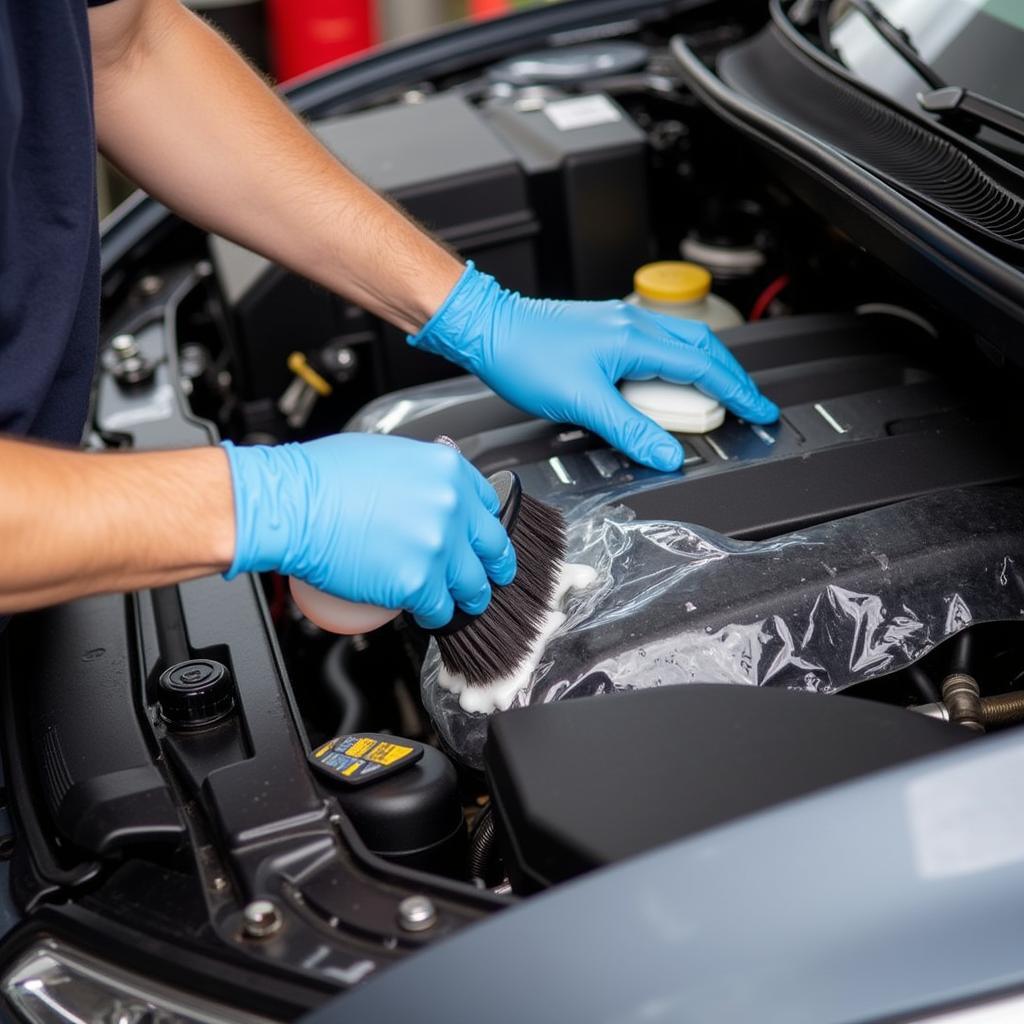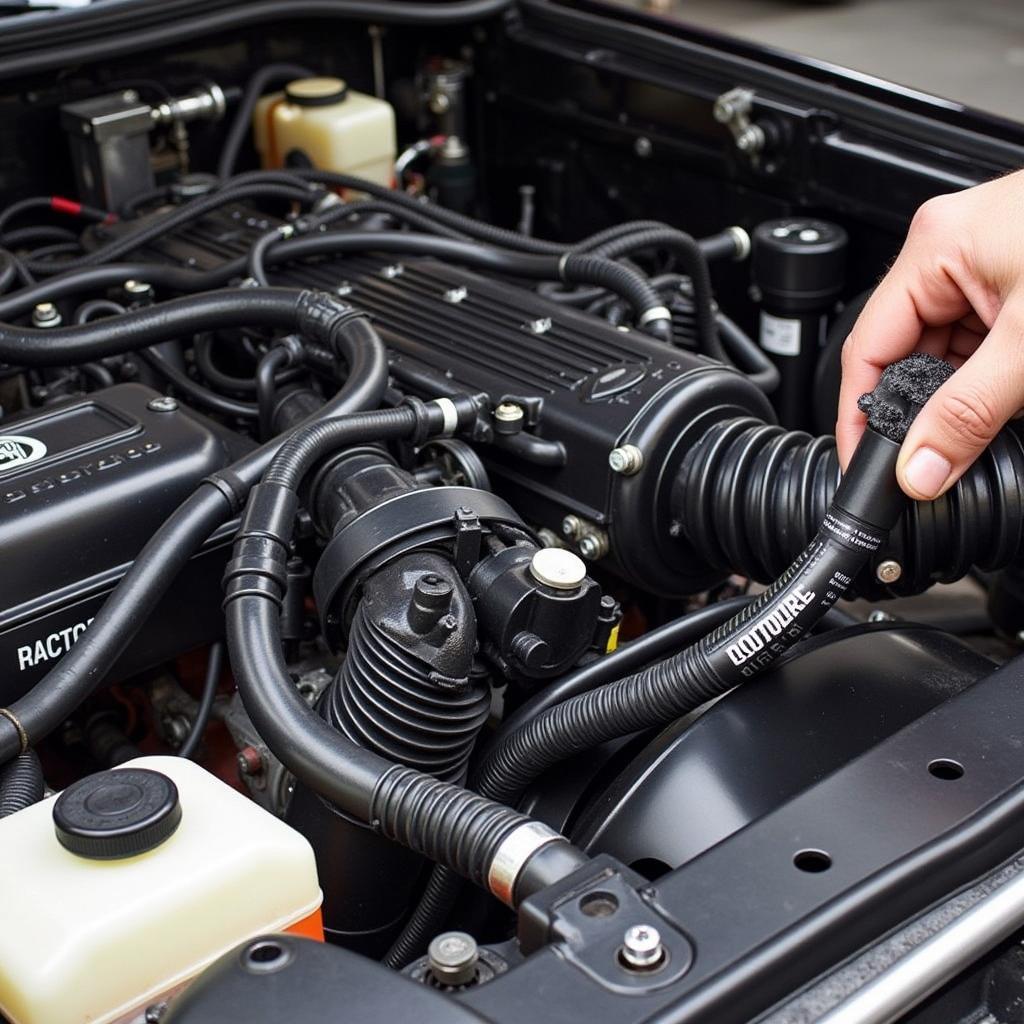Detailing the under hood of your car not only enhances its appearance but also protects vital components and can even improve performance. Knowing How To Detail Under Hood Of Car correctly can seem daunting, but with the right approach and a little patience, you can achieve professional-looking results. This guide provides a step-by-step process to help you achieve a showroom-worthy engine bay.
If you’re unsure about tackling the entire detailing process yourself, checking your car’s engine details might be a good starting point. how to check car engine details.
Preparing the Engine Bay
Before you begin detailing, ensure the engine is cool to the touch. Safety is paramount. Disconnect the negative battery terminal to prevent any electrical mishaps. This is a crucial first step.
Gathering Your Supplies
Assemble all necessary cleaning supplies and tools before you start. This includes a degreaser, engine cleaner, brushes (various sizes), microfiber towels, a garden hose with a spray nozzle, protective gloves, and eye protection. A plastic bag for covering sensitive components like the alternator and air intake is also recommended.
Cleaning the Engine Bay
Start by removing any loose debris, leaves, or twigs from the engine bay. Then, cover sensitive electrical components with plastic bags. Apply the degreaser liberally to the greasy areas, allowing it to dwell for the recommended time.
Rinsing and Washing
Using the garden hose with a spray nozzle, carefully rinse the degreaser and grime away. Avoid using high-pressure water, as this can damage sensitive components. Next, apply the engine cleaner and agitate with the brushes, paying attention to hard-to-reach areas.
 Cleaning Process of a Car Engine Bay
Cleaning Process of a Car Engine Bay
Drying and Protecting
Once thoroughly cleaned, rinse the engine bay again and dry with microfiber towels. For a showroom finish, consider applying a dressing to the plastic and rubber components to restore their original shine and protect them from future grime buildup.
Wondering if gadget detailing tools are suitable for cars? Explore this topic further: will gadget details work on cars.
Detailing Specific Components
Pay extra attention to areas like the battery terminals, fuse box, and wiring harnesses. Use a dedicated battery terminal cleaner to remove corrosion. A detail brush can be used to clean around the fuse box and wiring harnesses without causing damage.
Addressing Stubborn Stains
For particularly stubborn stains, consider using a stronger degreaser or a specialized cleaning solution. Always test the solution on a small, inconspicuous area first to ensure compatibility with the engine components.
Maintaining a Clean Engine Bay
Regularly cleaning your engine bay can prevent the buildup of grime and make future detailing sessions much easier. A quick wipe-down with a damp microfiber towel every few weeks can help maintain a clean and presentable engine bay.
Do professional car detailers clean every nook and cranny? Find out more here: do car detailers clean everything. Learning more about professional detailing services can provide valuable insights.
Conclusion
Detailing the under hood of your car is a rewarding task that enhances its appearance, protects vital components, and can even improve performance. By following this comprehensive guide on how to detail under hood of car, you can achieve professional-looking results and maintain a pristine engine bay.
FAQs
- How often should I detail my car’s engine bay? Ideally, every 3-6 months, depending on driving conditions.
- Can I use a pressure washer to clean my engine bay? It’s best to avoid high-pressure water, as it can damage sensitive components.
- What type of degreaser should I use? A dedicated engine degreaser is recommended.
- Do I need to disconnect the battery? Yes, disconnecting the negative terminal is a crucial safety precaution.
- How long should I let the degreaser dwell? Follow the manufacturer’s instructions for the specific product you’re using.
- What is the best way to dry the engine bay? Use clean, dry microfiber towels.
- Can I detail my engine bay without water? Yes, waterless car detailing methods are also an option. You can find out more here: how to detail a car without water.
Have you ever wondered how to access your car’s details? This link can be helpful: how to know my car details.
Expert Insight:
- John Smith, Automotive Engineer: “A clean engine bay allows for better heat dissipation, potentially improving engine performance.”
- Sarah Jones, Certified Car Detailer: “Regular engine bay cleaning prevents the buildup of grime that can attract rodents and cause corrosion.”
- David Brown, Automotive Technician: “Protecting electrical components with plastic bags before cleaning is crucial to prevent potential damage.”
 Sparkling Clean Engine Bay After Detailing
Sparkling Clean Engine Bay After Detailing
Need help with car detailing? Contact us via WhatsApp: +1(641)206-8880, Email: [email protected]. Our customer service team is available 24/7.

Leave a Reply